The Samsung Galaxy S6 and S6 edge Review
by Joshua Ho on April 17, 2015 9:00 AM EST- Posted in
- Smartphones
- Samsung
- Mobile
- Galaxy S6
- Galaxy S6 Edge
System Performance
In order to test the Exynos 7420 and the phone in general, we turn to our suite of benchmarks which are able to show how the device performs in common general computing workloads. Something as simple as web browsing is still surprisingly intensive on mobile phones, and in general Android can often be quite stressful to run in the constraints of a ~3W total TDP especially on any phone still running Dalvik due to its strong reliance on bytecode and a virtual machine that translates bytecode to machine code just before and during application runtime. ART improves this significantly, but is limited in the nature of optimization as AOT compilation optimizations are limited by the CPU power of the SoC and the need to compile the application in a reasonable amount of time.
As always, we'll start things off with our browser benchmarks. After getting to use the phone, it became clear to me that Chrome is poorly optimized against the Galaxy S6 as Samsung’s browser is clearly superior in performance. For that reason I've gone ahead and run our benchmarks on both Chrome and on the stock browser, as seen below.

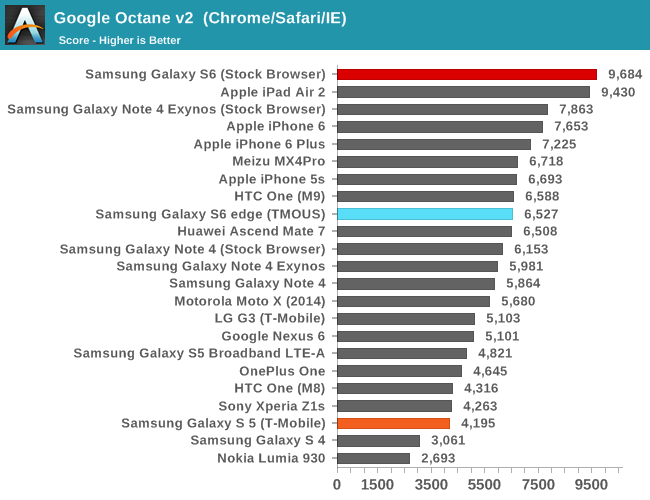

Needless to say, in order to see the full potential of the Exynos 7420 and its cluster of A57s, it’s necessary to use Samsung’s stock browser. This performance is really quite amazing when compared to Apple’s A8X, which has basically been the gold standard for performance in the mobile space in the context of ARM SoCs.
Moving on, as a part of our updates to the benchmark suite for 2015, we'll take a look at Basemark OS II 2.0, which should give a better picture of CPU performance in addition to overall device performance.
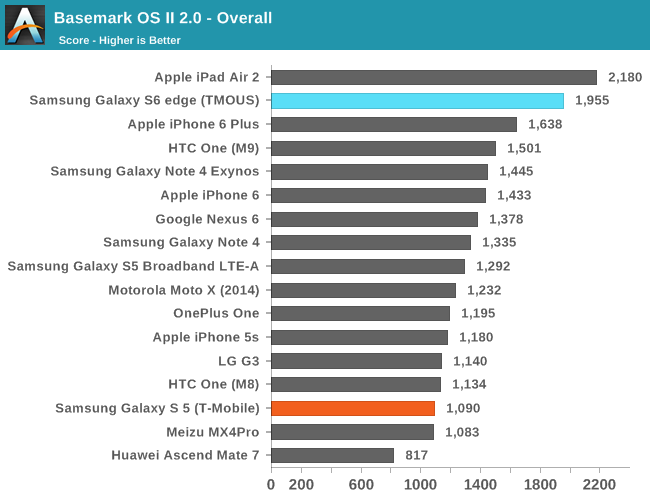
The browser benchmarks seem to hide some pretty enormous variability as the Galaxy S 6 edge (which is comparable to the Galaxy S 6) sets a new record among Android devices. The only challenger is the iPad Air 2, which uses the A8X SoC with three Enhanced Cyclone cores and the semi-custom GXA6850 GPU.
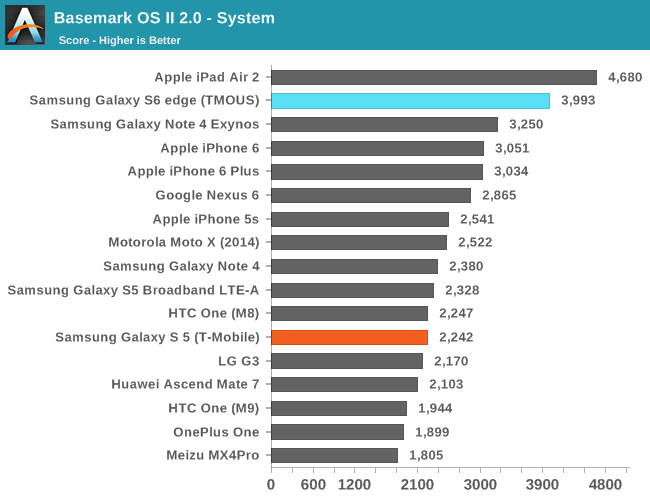
This system test contains a floating point and integer test, in addition XML parsing, which means that this test mostly stresses CPU and RAM. Interestingly enough, the Exynos 7420 pulls far ahead of both the Exynos 5433 and Snapdragon 810 in this test, and approaches the A8X. The difference between the 5433 and 7420 is likely a combination of the higher clocks on both the A57 and A53 clusters for the 7420 (1.9/1.3 on the 5433, 2.1/1.5 on the 7420), in addition to the ability to stay at a high 'overdrive' clock due to reduced leakage from the 14LPE process. The One M9 likely falls a bit short here due to HTC's governor settings restricting the use of all 8 cores simultaneously.

While one might guess that the memory test of 'Basemark OS II 2.0 - Memory' is of RAM, this is actually a test of the internal storage. Once again we see the S6 edge come close to leading the pack due to the use of the new UFS (Universal Flash Storage) standard. Casual examination reveals that the S6 edge has a queue depth of 16, and that it identifies itself with the rather cryptic model name of KLUBG4G1BD-E0B1.
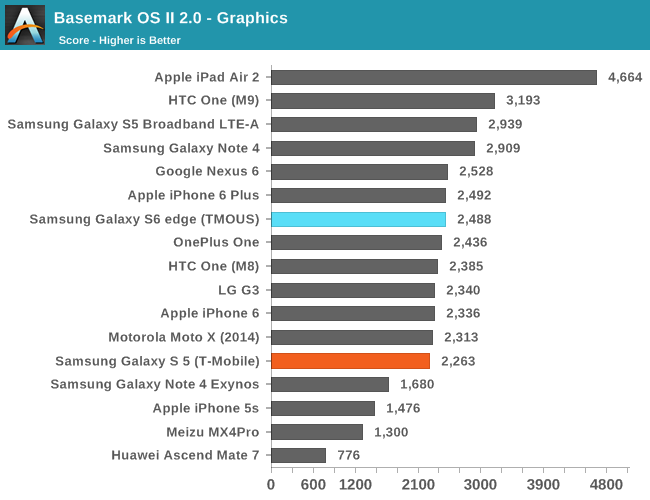
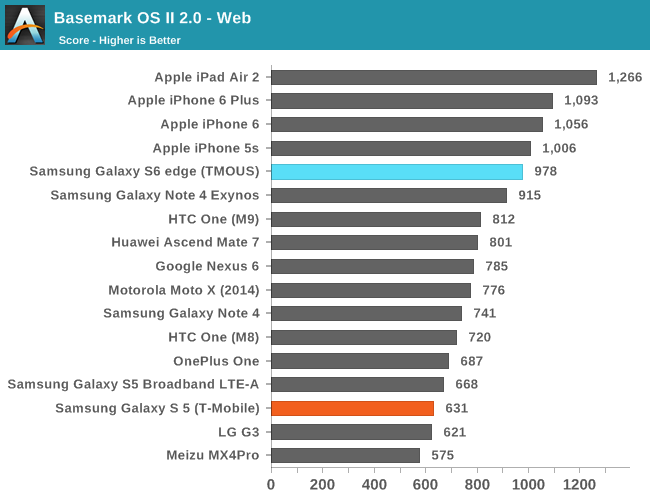
For the web test, it uses the built-in WebView rendering engine rather than Chrome and paints a distinctly different picture, especially because these tests are focused on HTML5 and CSS rather than JavaScript. Here we can see that the iPhone 6 and iPad Air 2 continue to hold their lead, but the Galaxy S6 is pretty much the king of the hill when it comes to Android devices.
Our next system benchmark is PCMark, which does a number of basic benchmarks designed to stress various aspects of the device in everyday workloads like video playback, web browsing, text editing, and photo editing. This tends to test every aspect of a mobile device, unlike microbenchmarks that can often miss aspects of the system that can affect performance.
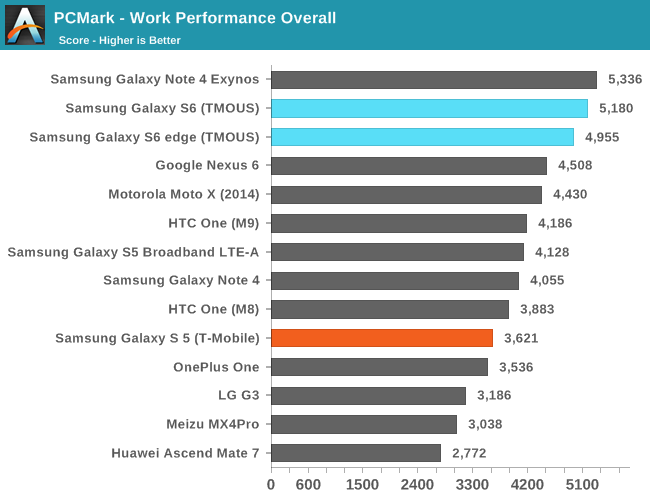
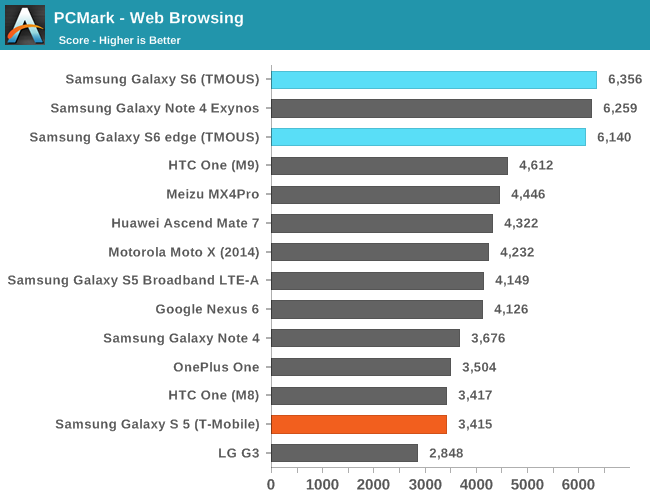
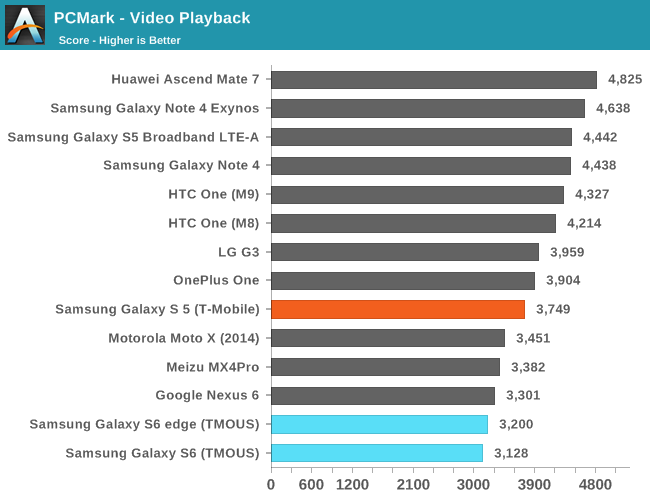
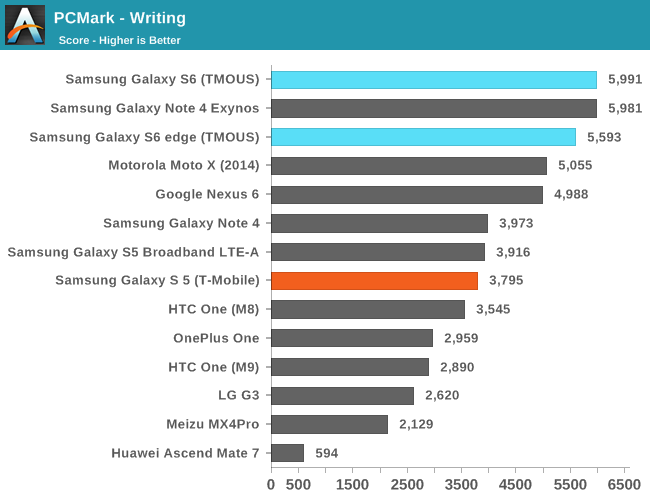

In these tests, the Galaxy S6 continues to perform strongly here due to the fast NAND storage solution and the Exynos 7420 SoC. As we have already covered the Basemark OS II 2.0 results in previous articles, I would refer back to it as those scores are final and have already been contextualized.
Overall, in these general purpose computing tasks that stress CPU, memory, and NAND performance we can see that the Exynos 7420 is off to a flying start. Samsung Mobile should focus more strongly on optimizing the software stack against Chrome as mobile Chrome has around twice the user share of stock Android browsers. I often say that the SoC is the foundation to a good smartphone, and in the case of the Galaxy S6 it feels like this is especially true.










306 Comments
View All Comments
akdj - Friday, April 24, 2015 - link
That's NOT the same display. The Note 4 was a step up from 5Active and this is an even bigger step 'up' for AMOLED. The anomalies have been talked about in many reviews. As well as some purple fringing shooting low light (w/light source, like a candle). Killer display though!Refuge - Friday, April 17, 2015 - link
I'm not entirely sure, I kind wish he had elaborated more on it. Especially when this is a flagship phone and he says there is a defect with the perfect screen.But they only thing I can think of is how it seems to reflect much like a bubble would in direct sunlight. Maybe there is a risk of this rainbow effect screwing with color accuracy in direct sunlight? I'm not entirely sure either.
Ammaross - Friday, April 17, 2015 - link
I see two vertical dark bars on left and right sides of the screen and one 1/4 from the top horizontally. Maybe that's what he's referring to...Peichen - Saturday, April 18, 2015 - link
I see the same thing as Ammaross. I guess some of you need to have your screen calibrated. I can see the dark bars on my home PC but I guess I won't be able to see it on the cheap/crap workstation at work.Maxpower2727 - Friday, April 17, 2015 - link
The only thing I saw in that photo was reflected light, which is to be expected with any phone and could hardly be considered a "defect." I really don't understand what he was getting at with that.JoshHo - Friday, April 17, 2015 - link
It was surprisingly hard to capture, but it's the photo of the horizontal/vertical bars when the display was under strong sunlight.arayoflight - Friday, April 17, 2015 - link
Josh, I think the front facing camera has a1/4.1" sensor, not 1/3". It was conformed by Samsung tomorrow.Also, the IMX240 has 1.2 micron pixels, not 1.12.
Correct these 2 mistakes. The review was great though.
JoshHo - Friday, April 17, 2015 - link
Apologies. I have fixed the FFC sensor size.To my knowledge the IMX240 uses 1.12 micron pixel size, going by Chipworks measurements and the released spec for the S5K2P2 sensor which has the same pixel count and sensor size.
arayoflight - Saturday, April 18, 2015 - link
The s5k2p2 has 1.12 micron size. Also they're both 1/2.6" and identical resolution.But 1/2.6" necessarily doesn't mean they're same size. It just tells the size of the disk and hence there can be a difference.
I think also on the Wiki page of IMX240 it's 1.2 micron. Though it's a different 4:3 IMX240 but I doubt they'll change the pixel pitch for a custom IMX240 used by Samsung.
Just look into it. Even I want to know the perfect pixel size :)
will54 - Monday, April 20, 2015 - link
Its the one horizontal stripe and the 2 vertical stripes on each side of the screen